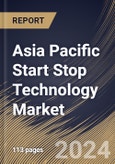The performance of start stop systems heavily relies on battery technology. Ongoing trends involve the development of advanced batteries with improved energy density, faster charging capabilities, and longer lifespans. Lithium-ion batteries and other emerging technologies are being explored to enhance the reliability and efficiency of start stop systems. Innovations in battery technology contribute to better start stop performance and address concerns about the longevity of batteries in these systems.
As the prevalence of electric vehicles increases, a developing trend toward smart grid integration emerges. Start stop systems are evolving to communicate with smart grids, allowing for strategic charging and discharging of vehicle batteries. This trend optimizes energy consumption and contributes to a more intelligent and efficient use of electric vehicles in the broader energy ecosystem.
According to the report titled Cities as Engines of Growth, published in 2022 by the Government of India, the population of urban areas in India is projected to have increased approximately fourfold, from 109 million in 1970 to 460 million in 2018. The country is projected to experience an additional 416 million inhabitants in its urban areas by 2050, resulting in a 50 percent urban population share. It is already the second-largest urban community globally. As per the State Council of China, urbanization has accelerated rapidly throughout China in recent years, with the National Bureau of Statistics estimating that the rate increased to 64.72 percent last year. As of the end of 2022, 914 million people were living in cities, an increase of 12.05 million from 2021. Therefore, due to the above-mentioned factors, the market will grow significantly in this region.
The China market dominated the Asia Pacific Start Stop Technology Market by Country in 2022, and would continue to be a dominant market till 2030; thereby, achieving a market value of $243 Million by 2030. The Japan market is registering a CAGR of 7.2% during (2023 - 2030). Additionally, The India market would showcase a CAGR of 8.5% during (2023 - 2030).
Based on Application, the market is segmented into Passenger Car and Commercial Car. Based on Type, the market is segmented into Belt-Driven Alternator Starter (BAS), Integrated Starter Generator (ISG), Direct Starter, and Enhanced Starter. Based on countries, the market is segmented into China, Japan, India, South Korea, Singapore, Malaysia, and Rest of Asia Pacific.
List of Key Companies Profiled
- Continental AG
- Robert Bosch GmbH
- BorgWarner Inc
- Denso Corporation
- Johnson Controls International PLC
- Valeo SA
- Hitachi, Ltd. (Hitachi Astemo, Ltd.)
- Mitsubishi Electric Corporation
- Aptiv PLC
- Aisin Corporation (Toyota Motor Corporation)
Market Report Segmentation
By Application- Passenger Car
- Commercial Car
- Belt-Driven Alternator Starter (BAS)
- Integrated Starter Generator (ISG)
- Direct Starter
- Enhanced Starter
- China
- Japan
- India
- South Korea
- Singapore
- Malaysia
- Rest of Asia Pacific
Table of Contents
Companies Mentioned
- Continental AG
- Robert Bosch GmbH
- BorgWarner Inc
- Denso Corporation
- Johnson Controls International PLC
- Valeo SA
- Hitachi, Ltd. (Hitachi Astemo, Ltd.)
- Mitsubishi Electric Corporation
- Aptiv PLC
- Aisin Corporation (Toyota Motor Corporation)
Methodology

LOADING...








